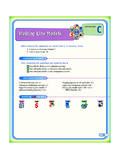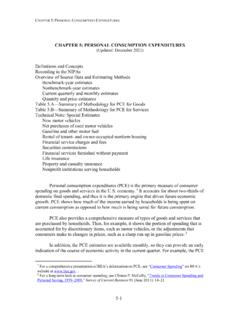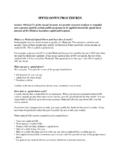Transcription of U.S. Personal Health Care Spending by Age and Gender
1 Personal Health Care1 Spending By Age and Gender 2014 Highlights All Payers: Total Personal Health Care Overall, female Spending reached $ trillion in 2014 and accounted for about 56 percent of total Personal Health care (PHC) Spending (females accounted for almost 51 percent of the population). Male Spending totaled over $ trillion and accounted for the remaining 44 percent. Per capita Health Spending for females was $8,811 in 2014, approximately 21 percent more than for males ($7,273). During the period 2002 to 2014, Health care Spending for females was higher than Spending for males for every PHC category of goods and services except for Other Health Residential and Personal Care (OHRPC). Medicaid is the largest payer for OHRPC and male Spending from Medicaid was percent higher than Spending on females in 2014.
2 On a per capita basis, Spending for adults over 85 in 2014 ($32,903) was almost 9 times that for children ($3,749). Children (0-18) Total Health care expenditures for male children in 2014 ($155 billion) exceeded Spending for female children ($136 billion), the only age group where this occurred. Per capita Spending for male children ($3,900) was 9 percent higher than per capita Spending for female children ($3,591) in 2014. Retail prescription drug Spending for male children on a per capita basis in 2014 ($325) was 36 percent higher than per capita Spending for female children ($240). Working-Age Adults (19-64) Per capita Spending for working-age adult females in 2014 ($7,962) was 26 percent higher than male per capita Spending ($6,334). Females between ages 19-44 spent 62 percent more per capita in 2014 than did males in the same age-group.
3 The significant difference in Spending is largely associated with the costs for maternity care; in particular, physician and clinic services Spending for females was over 91 percent more than for males. In 2014, aggregate Medicaid Spending was 26 percent higher for females, ($137 billion vs. $109 billion); however, on a per enrollee basis, males enrolled in Medicaid spent approximately 36 percent more than females in 2014 ($10,281 vs. $7,551) due to the relatively large portion of disabled male enrollees in this age group. 1 Personal Health Care expenditures (PHC) measures the total amount spent to treat individuals with specific medical conditions and excludes government public Health activity, and government administration, and the net cost of Health insurance, and investment in structures, equipment, and research.
4 Older Adults (65 and older) Health care Spending for females 65 and over in 2014 ($509 billion) accounted for over 58 percent of all Health care Spending for older adults , higher than their share of this population (56 percent). On a per capita basis, Spending on females 65 and over in 2014 ($19,700) was 7 percent more than Spending for males ($18,331), due in part to nursing care facilities and continuing care retirement communities and home Health care Spending for females being about twice that of males of the same cohort. Recent Findings - 2014 Spending for males increased percent on average between 2012 and 2014, faster than growth in Spending for females at percent. From 2012 to 2014, the proportion of Medicaid Spending accounted for by working-age adults increased from 52 percent to 55 percent due to increased enrollment from the Affordable Care Act.
5 The largest impacts on a per-enrollee basis was in the Medicaid Spending for males 45-64 where the per-enrollee Spending was $14,219 in 2012 compared with $12,395 in 2014 as lower cost adults were added to historically higher concentration of disabled individuals in this age group. Total PHC across all age groups increased percent per person on average from 2012 to 2014 about the same rate as Spending on children ( percent). Spending for older adults (65+) grew at a slower rate at percent. The relatively slow growth in older adults Spending per person can be attributed in part to baby boomers entering this age cohort, lowering the average age of this group. Also, aggregate Spending in Medicare slowed due to reductions and policy changes associated with the Affordable Care Act and competitive bidding which slowed Spending for durable medical equipment and other nondurable medical products.
6 Spending for working age adults increased faster at percent. The slightly faster increase in working age group can be attributed in part to increased insurance coverage through Medicaid and the Marketplace.


















